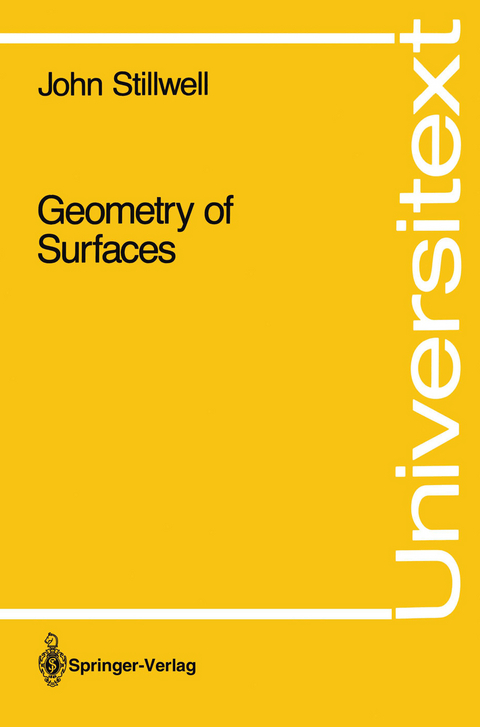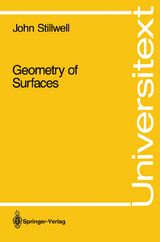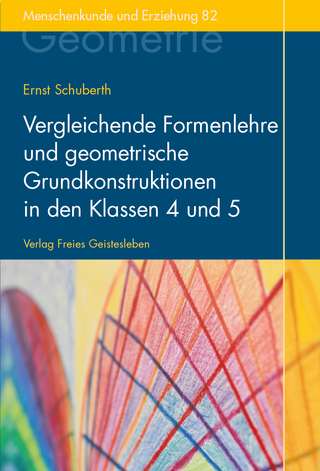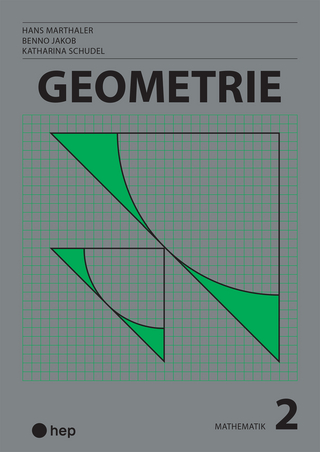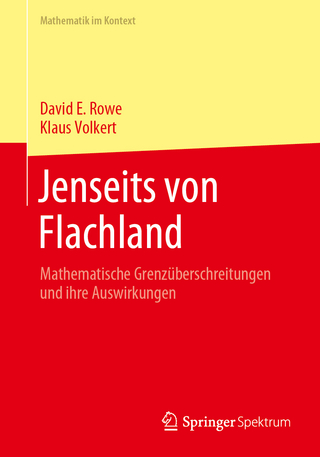Geometry of Surfaces
Springer-Verlag New York Inc.
978-0-387-97743-0 (ISBN)
Geometry used to be the basis of a mathematical education; today it is not even a standard undergraduate topic. Much as I deplore this situation, I welcome the opportunity to make a fresh start. Classical geometry is no longer an adequate basis for mathematics or physics-both of which are becoming increasingly geometric-and geometry can no longer be divorced from algebra, topology, and analysis. Students need a geometry of greater scope, and the fact that there is no room for geometry in the curriculum un til the third or fourth year at least allows us to assume some mathematical background. What geometry should be taught? I believe that the geometry of surfaces of constant curvature is an ideal choice, for the following reasons: 1. It is basically simple and traditional. We are not forgetting euclidean geometry but extending it enough to be interesting and useful. The extensions offer the simplest possible introduction to fundamentals of modem geometry: curvature, group actions, and covering spaces. 2. The prerequisites are modest and standard. A little linear algebra (mostly 2 x 2 matrices), calculus as far as hyperbolic functions, ba sic group theory (subgroups and cosets), and basic topology (open, closed, and compact sets).
1. The Euclidean Plane.- 1.1 Approaches to Euclidean Geometry.- 1.2 Isometries.- 1.3 Rotations and Reflections.- 1.4 The Three Reflections Theorem.- 1.5 Orientation-Reversing Isometries.- 1.6 Distinctive Features of Euclidean Geometry.- 1.7 Discussion.- 2. Euclidean Surfaces.- 2.1 Euclid on Manifolds.- 2.2 The Cylinder.- 2.3 The Twisted Cylinder.- 2.4 The Torus and the Klein Bottle.- 2.5 Quotient Surfaces.- 2.6 A Nondiscontinuous Group.- 2.7 Euclidean Surfaces.- 2.8 Covering a Surface by the Plane.- 2.9 The Covering Isometry Group.- 2.10 Discussion.- 3. The Sphere.- 3.1 The Sphere S2 in ?3.- 3.2 Rotations.- 3.3 Stereographic Projection.- 3.4 Inversion and the Complex Coordinate on the Sphere.- 3.5 Reflections and Rotations as Complex Functions.- 3.6 The Antipodal Map and the Elliptic Plane.- 3.7 Remarks on Groups, Spheres and Projective Spaces.- 3.8 The Area of a Triangle.- 3.9 The Regular Polyhedra.- 3.10 Discussion.- 4. The Hyperbolic Plane.- 4.1 Negative Curvature and the Half-Plane.- 4.2 The Half-Plane Model and the Conformai Disc Model.- 4.3 The Three Reflections Theorem.- 4.4 Isometries as Complex Functions.- 4.5 Geometric Description of Isometries.- 4.6 Classification of Isometries.- 4.7 The Area of a Triangle.- 4.8 The Projective Disc Model.- 4.9 Hyperbolic Space.- 4.10 Discussion.- 5. Hyperbolic Surfaces.- 5.1 Hyperbolic Surfaces and the Killing-Hopf Theorem.- 5.2 The Pseudosphere.- 5.3 The Punctured Sphere.- 5.4 Dense Lines on the Punctured Sphere.- 5.5 General Construction of Hyperbolic Surfaces from Polygons.- 5.6 Geometric Realization of Compact Surfaces.- 5.7 Completeness of Compact Geometric Surfaces.- 5.8 Compact Hyperbolic Surfaces.- 5.9 Discussion.- 6. Paths and Geodesies.- 6.1 Topological Classification of Surfaces.- 6.2 Geometric Classification ofSurfaces.- 6.3 Paths and Homotopy.- 6.4 Lifting Paths and Lifting Homotopies.- 6.5 The Fundamental Group.- 6.6 Generators and Relations for the Fundamental Group.- 6.7 Fundamental Group and Genus.- 6.8 Closed Geodesic Paths.- 6.9 Classification of Closed Geodesic Paths.- 6.10 Discussion.- 7. Planar and Spherical Tessellations.- 7.1 Symmetric Tessellations.- 7.2 Conditions for a Polygon to Be a Fundamental Region.- 7.3 The Triangle Tessellations.- 7.4 Poincaré’s Theorem for Compact Polygons.- 7.5 Discussion.- 8. Tessellations of Compact Surfaces.- 8.1 Orbifolds and Desingularizations.- 8.2 Prom Desingularization to Symmetric Tessellation.- 8.3 Desingularizations as (Branched) Coverings.- 8.4 Some Methods of Desingularization.- 8.5 Reduction to a Permutation Problem.- 8.6 Solution of the Permutation Problem.- 8.7 Discussion.- References.
| Erscheint lt. Verlag | 3.2.1995 |
|---|---|
| Reihe/Serie | Universitext |
| Zusatzinfo | XI, 236 p. |
| Verlagsort | New York, NY |
| Sprache | englisch |
| Maße | 155 x 235 mm |
| Themenwelt | Mathematik / Informatik ► Mathematik ► Geometrie / Topologie |
| ISBN-10 | 0-387-97743-0 / 0387977430 |
| ISBN-13 | 978-0-387-97743-0 / 9780387977430 |
| Zustand | Neuware |
| Haben Sie eine Frage zum Produkt? |
aus dem Bereich
